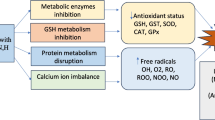Conclusions
-
1.
Judging by the intensity of the synthesis of DNA, the total population of hypophyseal cells of rats of the neonatal and nursing periods is more sensitive to the inhibitory influence of corticosteroids than cells of the hypophyses of animals of the prepubertal period and adults.
-
2.
The hypophyseal cells of rats of the early postnatal period react to corticosteroids with attenuation of the synthesis of intracellular proteins, while cells of animals of the prepubertal period and adults do not manifest this reaction.
-
3.
The marked inhibitory effect of the corticosteroids on hypophyseal cells of rats of the neonatal period is specific, since estradiol and testosterone do not alter the synthesis of DNA and total proteins, while progesterone exerts an insignificant inhibitory influence which is much weaker than the effects of corticosteroid.
-
4.
The inhibitory influence of dexamethasone on the synthesis of DNA in the hypophyseal cells of rats of the neonatal period is detected only with prolonged (1–3-day) incubation, whereas inhibitory influence of this glucocorticoid on the synthesis of total proteins is found after as little as 2 h of incubation and is maintained during chronic (3-day) exposure.
Similar content being viewed by others
References
I. S. Komolov, L. G. Morozova, I. Fazekash, et al.,Byul. Éksper. Biol.,85, No. 2, 215–217 (1978).
I. S. Komolov, V. P. Fedotov, D. Rappai, et al.,Ibid.,105, No. 4, 481–483 (1988).
M. A. Krasil'nikov,Vestn. AMN SSSR, No. 3, 55–59 (1990).
V. P. Fedotov, V. I. Gudoshnikov, and A. Ya. Kurishko,Farmakol. i Toksikol., No. 5, 57–61 (1988).
The Functions of the Adrenals in Fetuses, Newborns, and Infants in Arms, V. A. Tabolin (ed.) [in Russian], Moscow (1975).
V. G. Shalyapina and N. A. Chemyrtan,Probl. Éndokrinol.,29, No. 5, 55–59 (1983).
E. Carbajo-Perez and Y. G. Watanabe,Cell. Tiss. Res.,261, 333–338 (1990).
E. R. De Kloet, P. Rosenfeld, J. A. M. Van Eekelen, et al.,Progr. Brain Res.,73, 101–120 (1988).
J. S. Hyams and D. E. Carey,J. Pediat.,113, 249–254 (1988).
J. Kraicer, M. Herlant, and P. Duclos,Can. J. Physiol. Pharmacol.,45, 947–956 (1967).
M. Moguilewsky and J. P. Raynaud,J. Steroid Biochem.,12, 304–319 (1980).
M. Sakly and B. Koch,Endocrinology,108, 591–596 (1981).
R. M. Sapolsky and M. J. Meaney,Brain Res. Rev.,11, 65–76 (1986).
S. M. Sato and R. E. Mains,Endocrinology,119, 793–801 (1986).
H. Stepien, E. Karasek, and M. Pawlikowski,Biochem. Biophys. Res. Commun.,100, 1531–1536 (1981).
Author information
Authors and Affiliations
Additional information
Translated from Problemy Éndokrinologii, Vol. 38, No. 1, pp. 61–64, January–February, 1992.
Rights and permissions
About this article
Cite this article
Gudoshnikov, V.I., Fedotov, V.P. The heightened sensitivity of hypophyseal cells of neonatal rats to corticosteroids. Neurosci Behav Physiol 23, 107–111 (1993). https://doi.org/10.1007/BF01189104
Received:
Issue Date:
DOI: https://doi.org/10.1007/BF01189104




